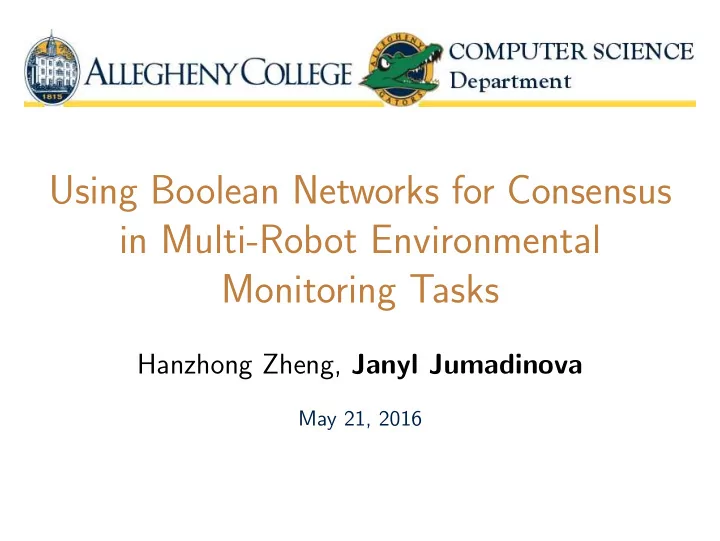

Using Boolean Networks for Consensus in Multi-Robot Environmental Monitoring Tasks Hanzhong Zheng, Janyl Jumadinova May 21, 2016
Autonomous Multi-robot Environmental Monitoring An cooperative, interactive robotic team to survey an environment for a particular event 2/17
Autonomous Multi-robot Environmental Monitoring An cooperative, interactive robotic team to survey an environment for a particular event Challenges of multi-robot systems: ◮ Large degree of complexity from movement coordination and communication ◮ Incorrect sensor reading 2/17
Multi-robot System Applications Manufacturing Landmine detection Search and Rescue 3/17
Particular Event Monitoring Fire Rain Intruder 4/17
Challenges in Current Multi-robot Applications ◮ High dimensional environmental information 5/17
Challenges in Current Multi-robot Applications ◮ High dimensional environmental information ◮ Communications and task collaboration between robotic team members 5/17
Challenges in Current Multi-robot Applications ◮ High dimensional environmental information ◮ Communications and task collaboration between robotic team members ◮ Environmental data misinterpretation and aggregation 5/17
Boolean Networks in Multi-robot Environmental Monitoring: ◮ non-complex method of corroboration, ◮ while still retaining meaningful information 6/17
Boolean Networks (BNs) ◮ The state of the node is either ON (1) or OFF (0) ◮ The state of a node is updated according to a Boolean rule ◮ The Boolean rule determines state transitions of the nodes ◮ Can use BNs to explore the dynamics of the network or just some relevant nodes ◮ BNs have been used to model various real networks: genetic regulatory networks, strongly disordered systems common in physics and biology 7/17
Boolean Networks with 3 nodes 8/17
Boolean Networks using Robotic Team 9/17
System Flow Chart 10/17
p ( t ): ratio of nodes in the network with a 1 state to the total number of nodes r n ( t ): previous state of the node n s n ( t ): current state based on sensor input of the node n 11/17
Experiments Experiment set up: 3 scenarios using 4 Turtlebot II ◮ Object remains still ◮ Object alternates its status once ◮ Object constantly alternates its status Source: http://learn.turtlebot.com/2015/02/03/4/ 12/17
Experiment Results Accuracy Table Testing Case Accuracy Scenario 1 98% Scenario 2 91% Scenario 3 85% Table: Accuracy of the aggregated states from the physical experiments. 13/17
Simulations 14/17
Simulations 15/17
Summary 1. The Boolean network based on multi-robot environmental monitoring system can produce significant information while maintaining high accuracy. 2. The mean-field approach based mathematical modeling used to approximate the aggregated state in aggregation process. 3. We study the behaviors of the system with various model parameters. 16/17
Future Work ◮ Conduct more experiments with robots. ◮ Statistical comparison of Boolean network with other commonly used aggregation methods. jjumadinova@allegheny.edu http://cs.allegheny.edu/sites/jjumadinova 17/17
Recommend
More recommend